
Reflecting on the Butcher

Blog 67 by Tan: Day 5 on the dirt – Reflecting on the Butcher
Day 5 of off road riding
131km from Kananga to an unknown tiny village
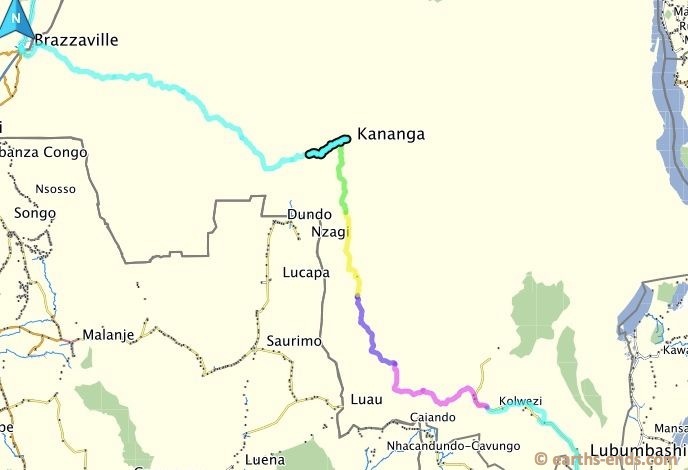
Our day’s travel.
So by the time we did all the fuel gathering and money-changing Mick described in the last blog post, we found ourselves leaving Kananga quite late in the morning… but we were not in a hurry. A little bit the opposite actually. After hitting Kananga only 4 days after leaving Kolwezi, we realised that by riding 10hrs a day we were setting a cracking pace along the route, and if we didn’t actively slow down our progress it would be over far faster than we had imagined or indeed wanted. So slow down we did.
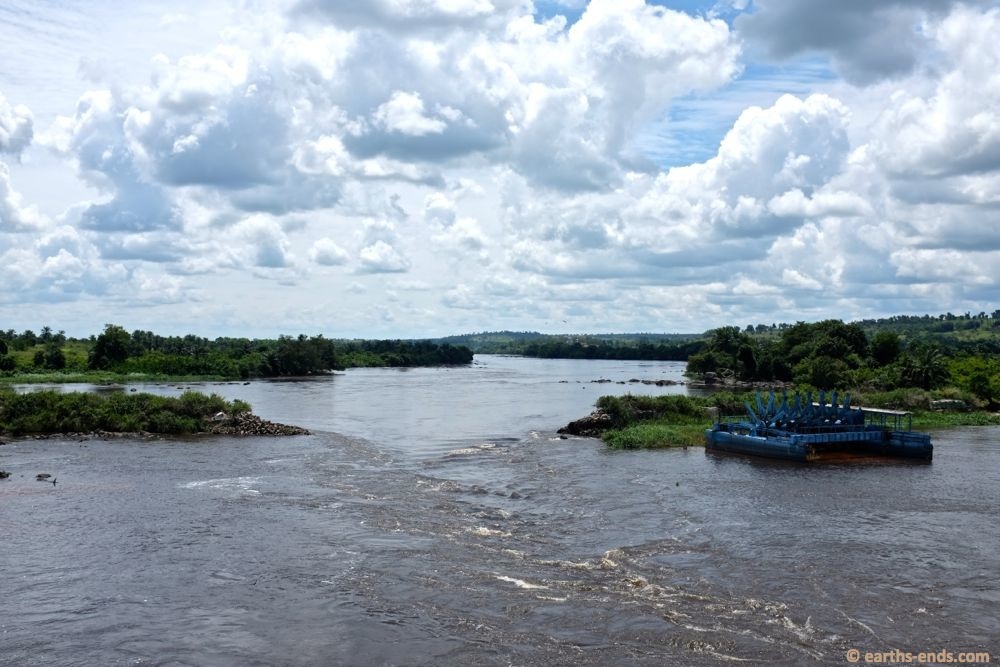
We had enough privacy to take a sneaky photo off the bridge out of town. Here we could see the relics of what looked like an old hydroelectric generator.
The bikers who had insulated us from encroaching police officers while we were changing money continued their guard of honour/protective swarm about us as we left town. Yahoo-ing motorbike riders, tooting their horns and goofing off excitedly, surrounded us from all sides. It was obvious they intended to lead us to the edge of town with the intention of keeping any traffic police well away from us. It was so nice we couldn’t help but smile. And it worked; this time not a single copper got the chance to fine us for any real or manufactured wrongdoing. It was a nice end to a less than ideal beginning to our visit to Kananga.
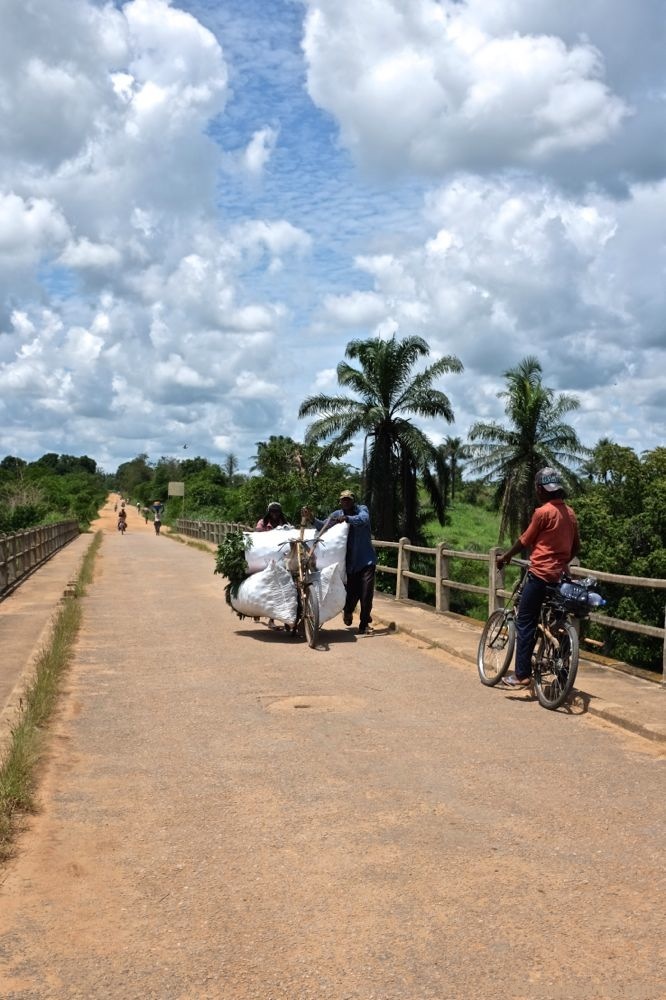
On the outskirts of town.
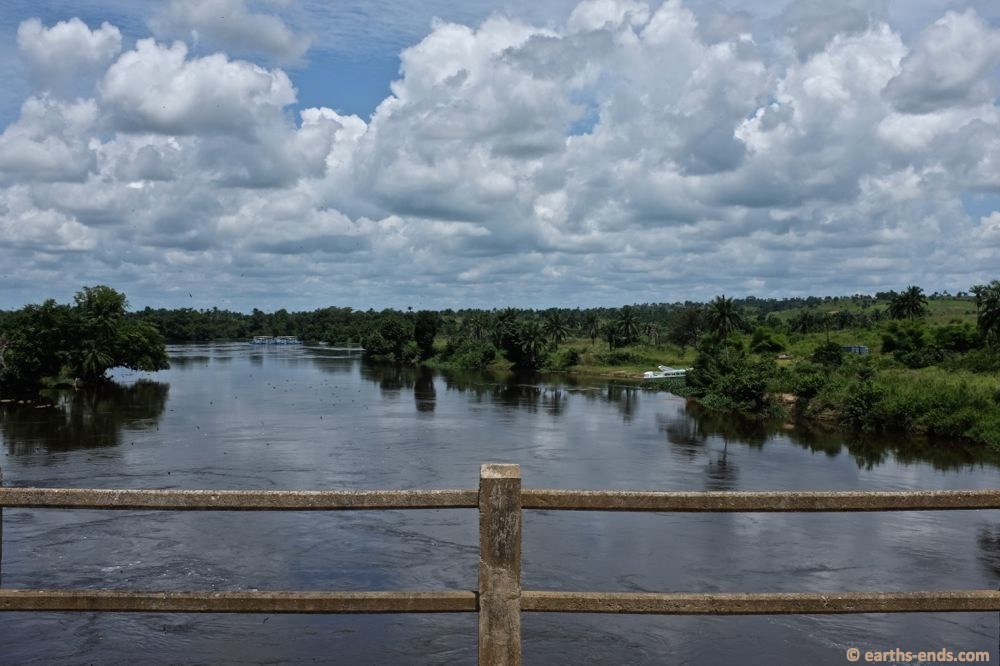
One of the Congo River’s many tributaries.
It didn’t take long before we were clear of Kananga’s city limits and we were back to the familiar comings and goings of the track. The crowds disappeared, along with most vehicular traffic, the noise was also gone and we found ourselves mostly alone once more. It was instantly relaxing despite the increased difficulty of the riding.
It is quite well known that one of the worst sections of the Lum-Kin crossing is the deep sand section between Kananga and Tshikapa. This is the one section where research had told us a full day’s ride might rack up all of 100km. Pat, riding solo on his very well set up KTM 690, had managed a whopping 98km from sunrise to sunset in this area during his recent crossing. She sounded like a doozy. The next couple of day’s riding was likely to be tough, but we were up for it. Despite mounting fatigue, we had found our DRC groove.
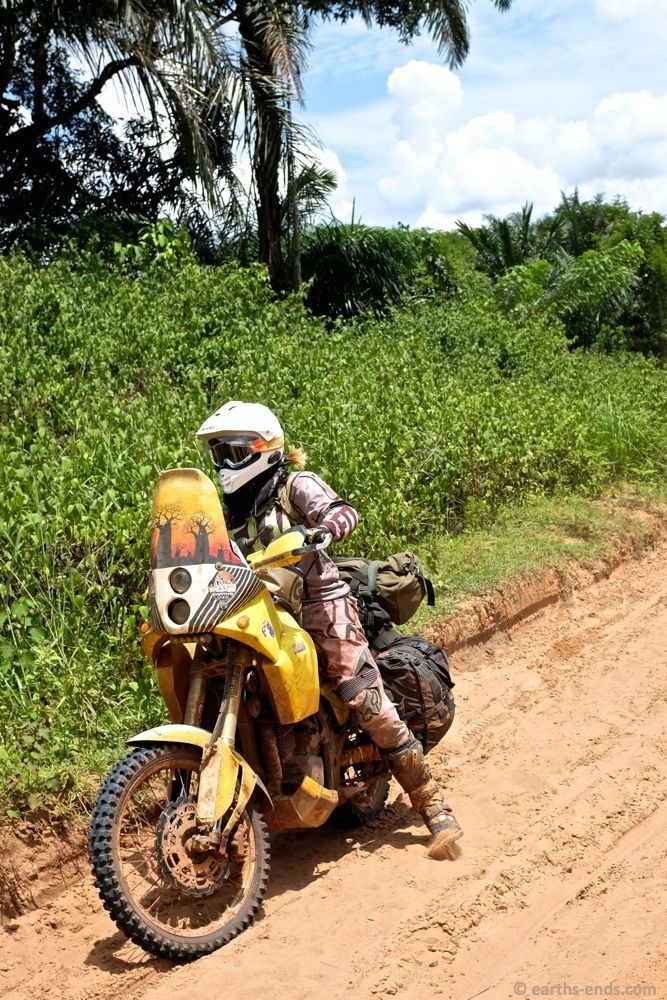
Sand. Everybody’s favourite. I think I was just getting started again hence the bad form.

Keeping up a good pace in the sand was made a bit tricky by the presence of people on the track.
While the road we had ridden north from Kolwezi to Kananga alternated between sand and red clay, we knew from now on it would be sand all the way to the tar. And it wasn’t long before it became increasingly soft and deep. Mick and I have done plenty of off-road riding and are comfortable riding sand. But this jungle sand was not too much like your conventional desert, river, or beach sand. Being the wet season it was quite water logged and heavy, but with the truck traffic constantly churning up the track, it was also quite loose. Normal sand technique of riding in the more consolidated vehicle ruts was just not realistic. They got so deep that if you were unlucky enough to drop in one, you were a pin ball bouncing from one side to another, and they generally weren’t even very consolidated as the very depth of them meant the sides would fall in making a loose bottom. So they were very unattractive, add to that the problems of being in a half meter deep rut when a 6×6 truck came along…
The next best sand riding technique of finding a virgin line to get up on the sand and wide enough to float around on was pure fantasy – the only thing untouched here was impenetrable jungle. So we were constantly picking the best looking lines, generally made by the velo-boys, either side of the truck ruts.
Even out of the ruts, it took a lot of effort on the bike to get through the sand without bogging or deviating from the often very narrow ridable line between the ruts and thick vegetation. Add to that having to keep up speed to avoid bogging whilst dodging pedestrians and velo-boys… it made it tricky. It was like trying to thread a needle while running. It took a heck of a lot of physical effort. And swapping sides of the track for the best line meant crossing the ruts, which was just murder on the poor bikes. But with staying in the ruts even worse for the bikes, there really was little to be done to spare the DR piggies.
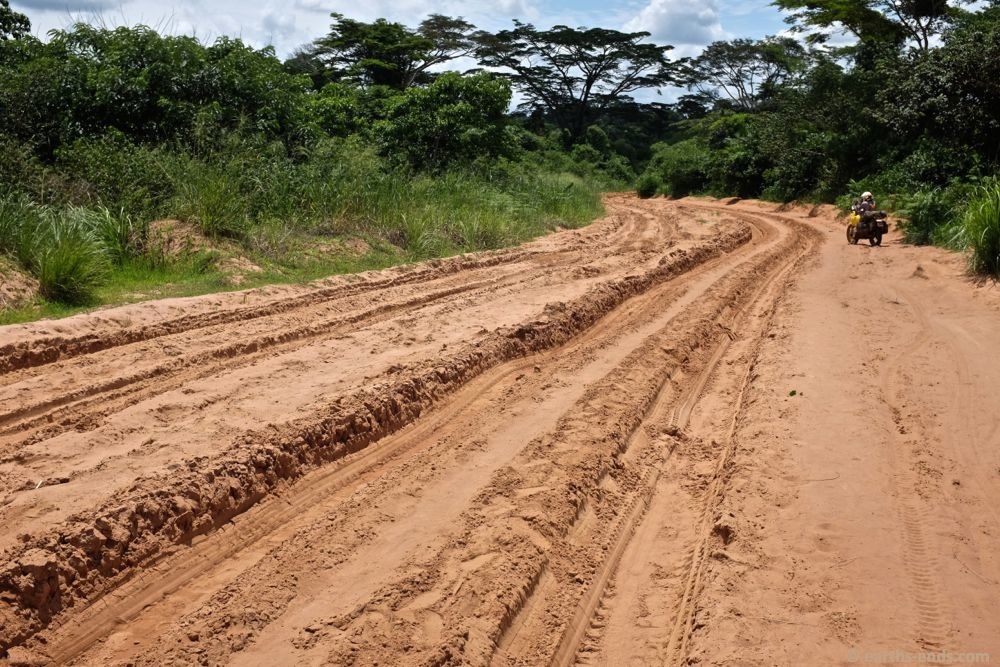
In this photo the sand doesn’t look that bad, right? I mean the wheel ruts look fine. They are not.
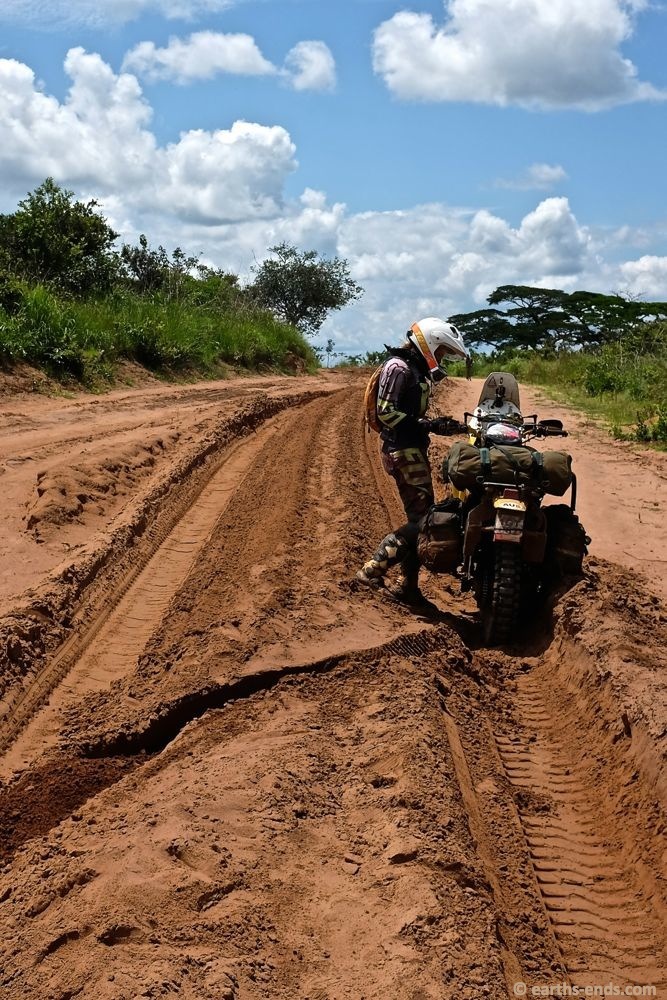
Me wanting nothing to do with this rut.
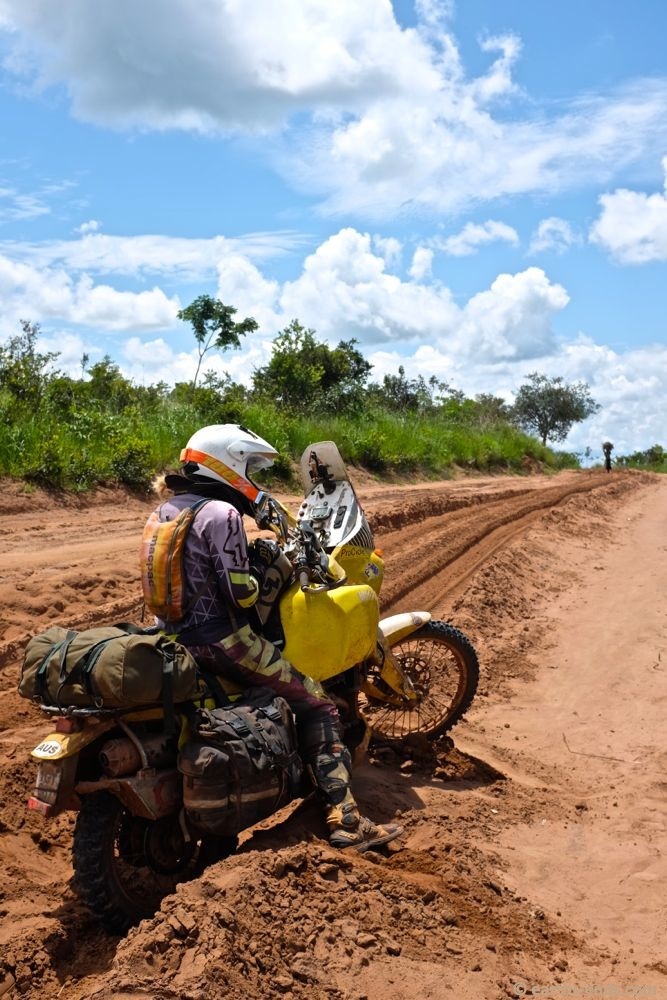
We had to ride in the ruts for most of the time on this section of truck and it was slow and frustrating.

But then we found an easier line.
But to be honest it wasn’t until the following day that the sand got its most challenging. Today’s sand riding was just slow and frustrating more than anything. It was either sandy narrow porters track bordered by thick vegetation, or it was wide truck track that was rutted to every hell imagined. We alternated between these two types all day. Just when you were convinced that the deep sand on the narrow porters trails were the worst to ride, we would end up on some wide and rutted truck track; and then you’d realise that “nope, this is definitely worse.” Then it would change back and you would be like “No! What was I thinking? This is clearly more awful.” For me the newest challenge was the worst one. Yet to break up the monotony and momentarily distract from the difficulty, you welcomed the change… then cursed it in the next breath.
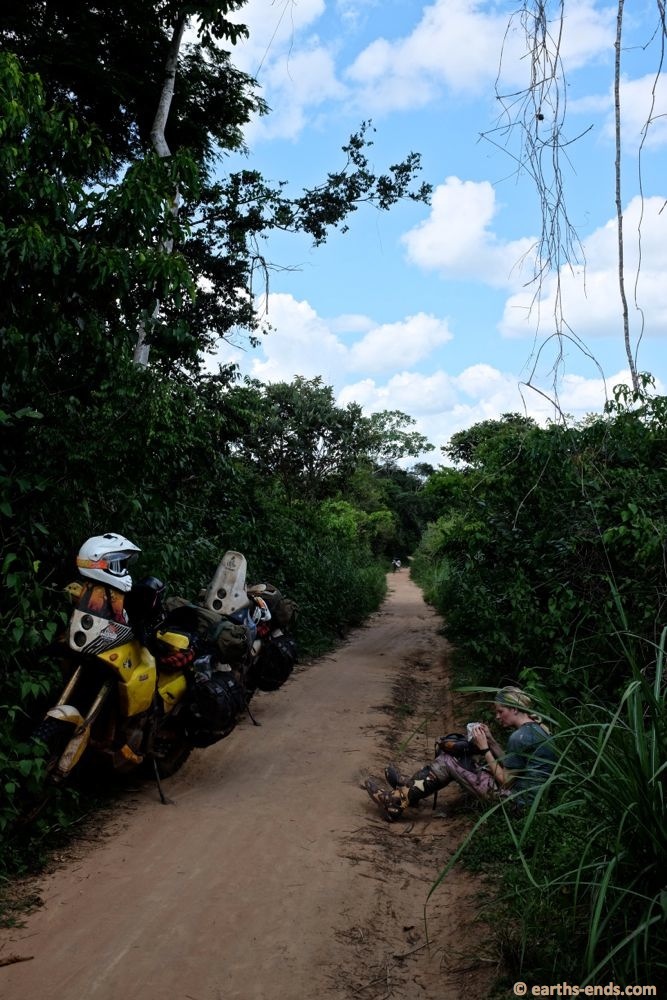
We found a nice little side track to pull up and have a rest and a snack.
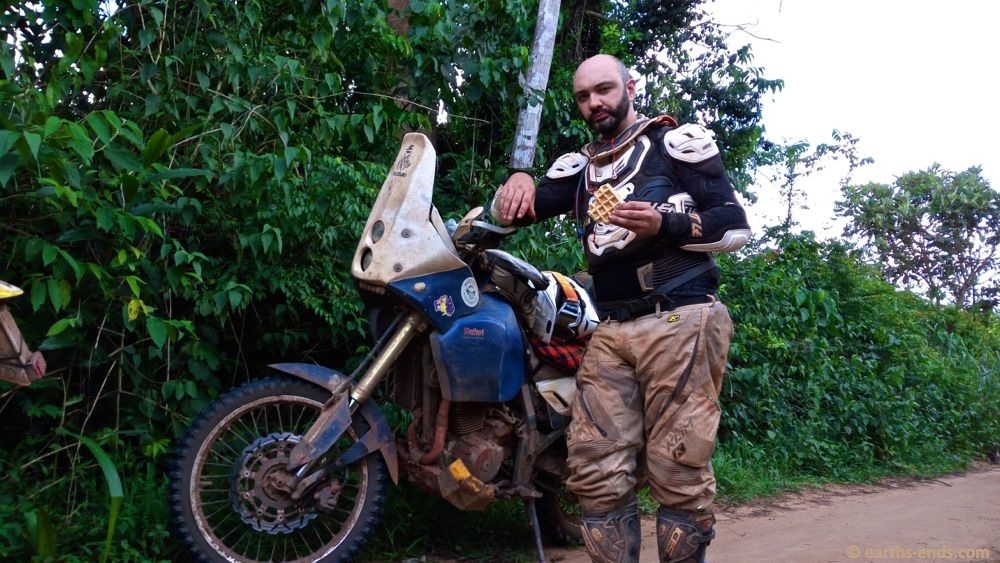
Belgian waffles in the former Belgian Congo. We grabbed these badboys before leaving Kananga. Wish we had filled our bags with them.
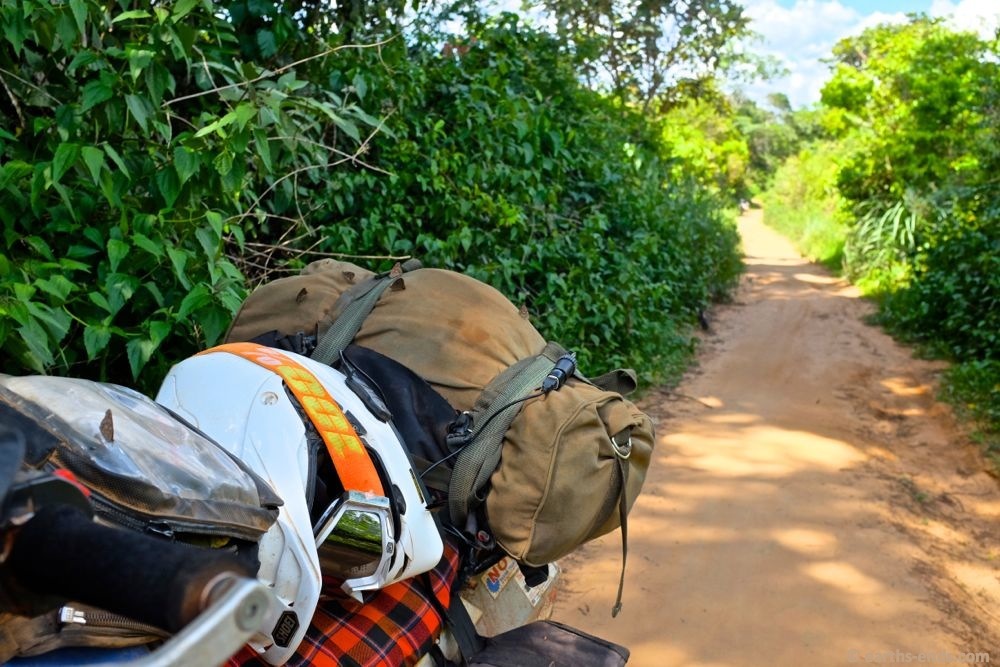
Doing some intercom charging. Being able to chat was especially helpful during the ride – although most exchanges were groans, grunts and profanity.
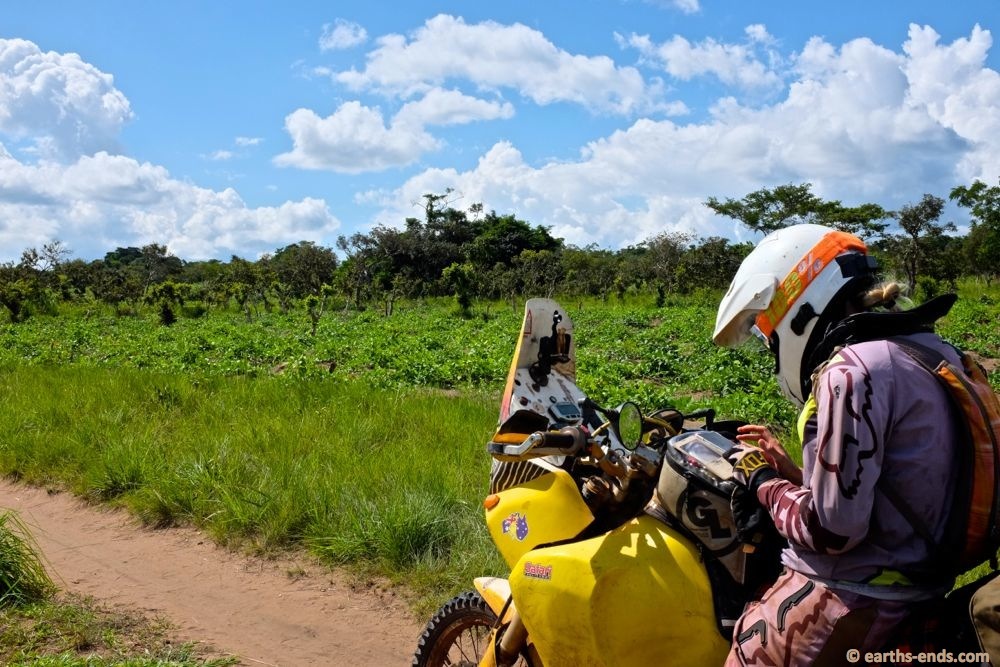
Finding some sweet beats to ride to.
In the worst of it we sought out walking tracks directly through the villages, often riding within touching distance of huts while dodging villager’s chickens and pigs. It also had the added bonus of giving us more of a look at daily life in the village, from mothers battling to braid their kids hair, men playing cards and young girls pounding the fufu that is the staple of food in these parts. These village tracks were the best of the cheat lines and gave us and the bikes some rest.
The bikes were rising admirably to all challenges but it was clear we were giving them absolute hell. They were rarely getting into 3rd gear and were working hard, which we could see on the temperature gauge. Normal riding on the highway they sit at around 100 deg, but out here they were sitting constantly around 120 to 130C. That’s when you were moving alright, that is. Go through a village or almost get bogged and you we easily running 140C or above.
Our bikes are well set up for this kind of thing but in the end I would say a bike like ours would be about the upper limit of what should be used on DRC’s serious off-road. I think if you are quite decent on a bike off-road, at this size you can still enjoy the ride. But any bigger and it would just be so slow, and involve so much pushing and digging and muscling of the bike, that it honestly wouldn’t be worth the discomfort and lack of enjoyment for me.
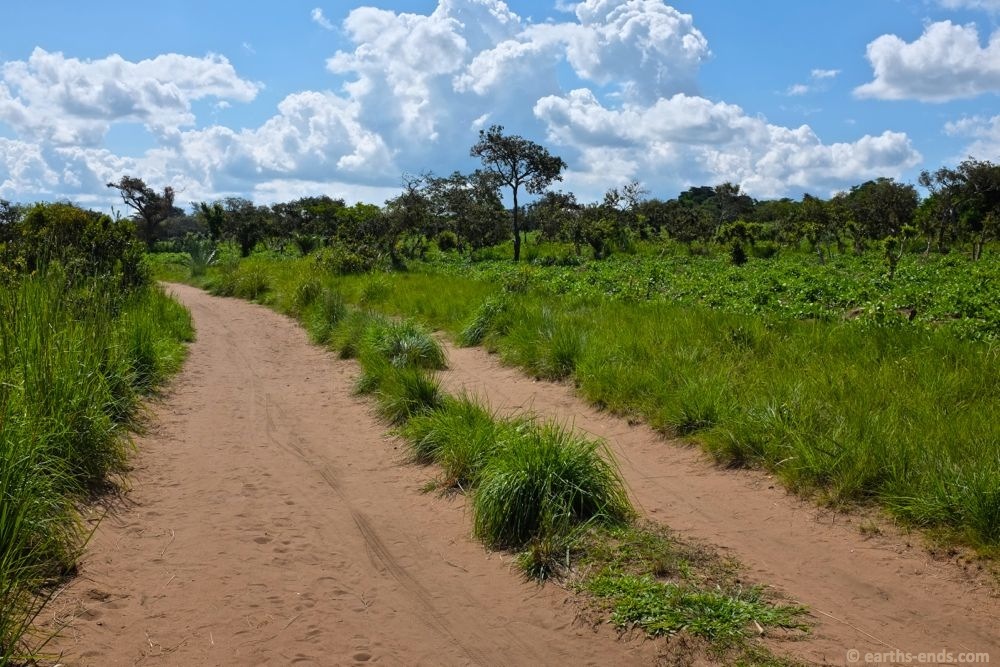
We did get some easy and glorious bits of track.

But most of it was this diabolical shit.

Welcome to “Bog City”- population: Us
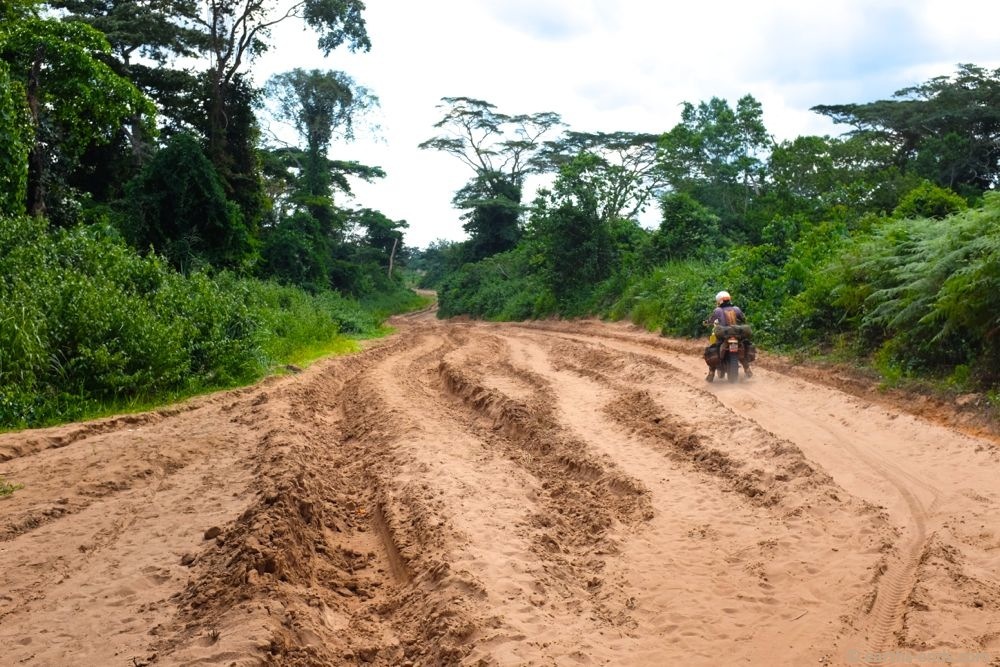
This was soft and chopped up but not too bad.
This thought was reinforced when we came across a few little China bikes on the track. We hadn’t seen many of them outside of the bigger towns and couldn’t help but look in envy at the comparative ease with which these bikes managed the track. They were lightweight and with such a low centre of gravity they made it look effortless. Our riding on the other hand could hardly have been described as such. Nevertheless, slowly but surely we progressed through the day. No crashes or drops or anything spectacular like that, just the odd bogging.
It was slow, tough toil; a largely uneventful day of determined riding in the peace and quiet of the Congo Jungle. A nice quiet day on the trail was indeed welcome after Kananga, and presents the added benefit to this blog that I get a chance to talk a little about the founding of the Congo Free State by King Leopold II of Belgium. WARNING: Heavy history comin’attcha!
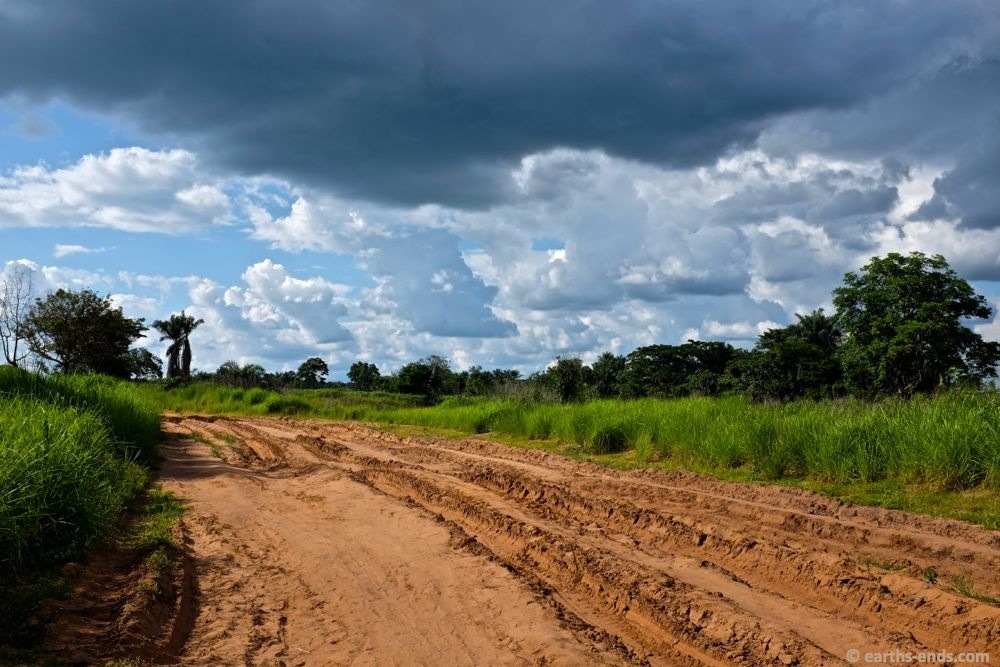
Most of this was rubbish to ride but then the odd easy, flat line appeared. If you were lucky you could get on it. If not you remained stuck in you shitty rut for ages.
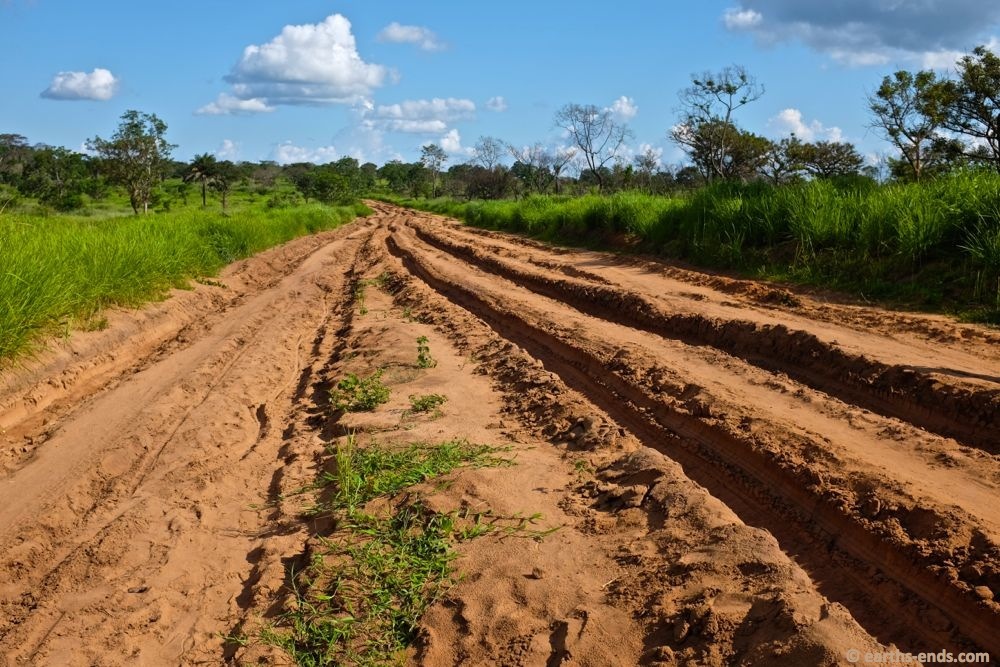
Arrgghh! Most of this stuff was awful no matter which line you took. The lines on the left were extremely soft and loose. The deep ruts were firmer but pin-balled the bike like mad. And the firm lines of the middle mound were extremely hard to get on to and harder still to stay on. And the firm line on the far right often ran out and dropped you straight into the ruts. Where you stayed until another option presented itself. That option would invariably be a bit shit too.
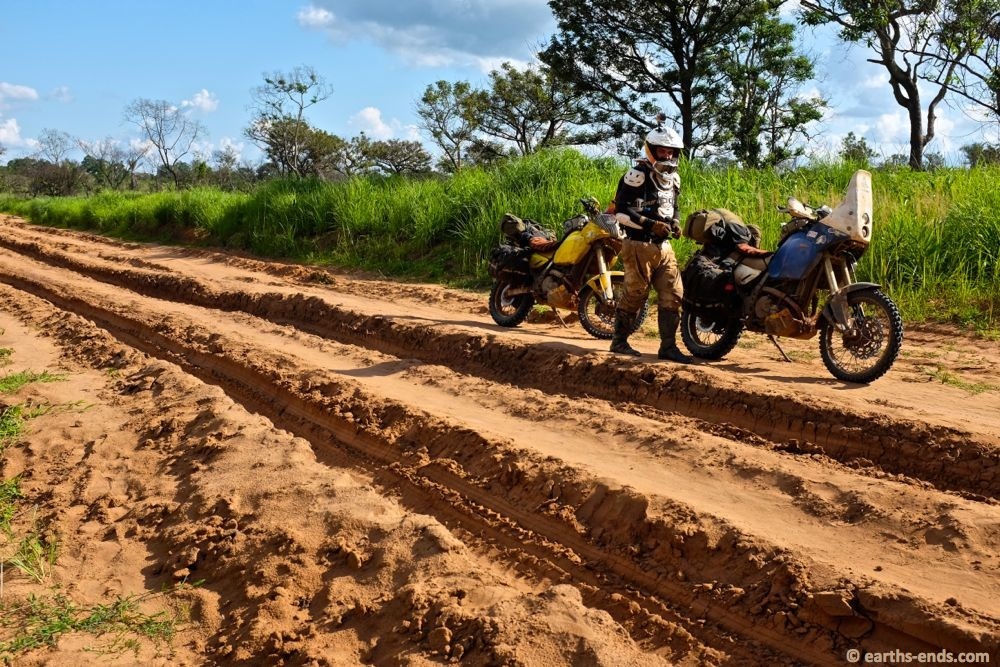
Soft and water-logged but far from the trickiest of stuff.
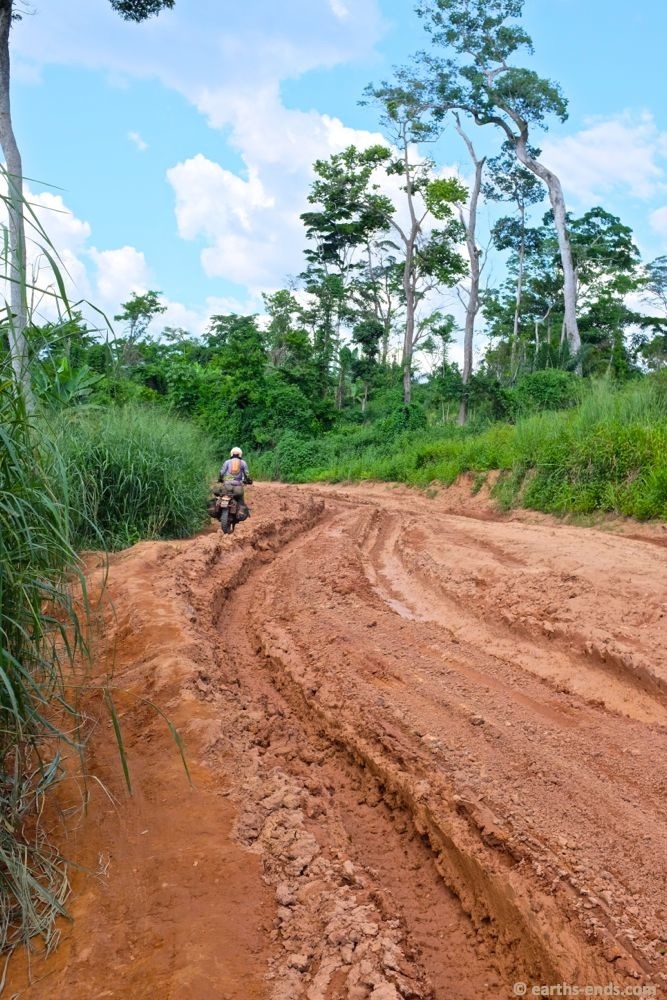
This stuff was really rubbish. And this muddy, foamy sand was really bad for the bikes. So we rode this line on the far left, which was physically more difficult-especially at the end of the day and in the heat and humidity. It was slippery and had a steep camber.
This subject represents another important link in the ‘chain of pain’ of Congo’s history that one of our online AdvRider mates (LotusJones) so profoundly described as being ‘so long as to bind so many’. It is also a good subject to ponder on the back of the last blog post’s overtures of police corruption. Corruption in DRC gets a lot of attention and I would hate people to perhaps be under the impression that this is somehow a problem with the Congolese themselves… like they have an inherent corruptibility or are more disposed to abuse power than any others. Because the fact of the matter is that this behavior, the abuse of power and exploitation, has been the modus operandi here since the first time the Congo was exposed to the outside world.
I figure most of you would have heard of Mobutu who ruled Congo for 32 years from the mid sixties, enriching himself and his cronies fabulously while his country crumbled beneath him. Well, before he came along there was a Belgian king named Leopold the second, who wrote the ‘Autocrats Guide to Pillaging a Nation’ which Mobutu read from and later perfected. Let me tell you few parts of the story of “the vilest scramble for loot that ever disfigured the history of the human conscience” – Joseph Conrad, author of “Heart of Darkness”.

King Leopold II – AKA The Butcher of the Congo.
The story of the founding of the Congo Free State is brilliantly captured in the highly readable book ‘King Leopold’s Ghost’ by Adam Hochchild. To summarise: it tells the tale of a tall, awkward, ZZ Top bearded Belgian King with a serious case of ‘little country syndrome’ and raging ‘empire envy’ who went on to dupe the world, enslave a country and kill roughly 10 million Congolese. All rather obscenely, in the name of ‘humanity.’
It was the latter part of the 19th century when imperialism was all the rage and marriage to first cousins de rigueur. Subsequently Europe found its monarchies full of weird looking royals with colonial ambitions considerably deeper than their gene pools. One such royal was Leopold II, King of the Belgians.
Young Leopold was none too pleased with the tiny size of the country he was in charge of, nor the quality of the people who filled it. He never bothered to learn Flemish, the language of the majority of his people; such was his opinion of them. “Belgium – small country, small minds” he was famously quoted as saying.
Leopold, like many at that time, was convinced that a nation’s greatness had much to do with the amount of loot it could hungrily siphon from its colonies. And there he was, with a young, small, unimportant country and NO colonies, surrounded by the might of France, up-and-coming Germany, the Spanish and Portuguese empires and that of his first cousin Queen Victoria of England. Even little ol’ Holland had colonies. ‘Why couldn’t he?’ he (most likely) internally raged.
To add to his woes Belgium was afflicted with one of those pesky parliaments, which were destroying all the fun that once existed for a monarch during the old glory days of absolute power. A politician once delivered Leopold what was meant to be a compliment that ‘he would make a great president of a republic’. He was reported to have turned to his confidant and personal physician with scorn and asked him “What would you say doctor, if someone greeted you as a great veterinarian?”
So with democracy cramping his style at home, Leopold settled on getting a colony of his own so he could stand with the big boys and do whatever he wanted. So desperate was he for colonies that he tried to buy lakes in the Nile delta with the idea of draining them and claiming the land as a colony. He tried and failed to purchase a part of Argentina, then an island off Uruguay, then the Philippines, then Fiji. He even tried to lease the island of Formosa (modern day Taiwan). No luck. So he set his sights on Africa.
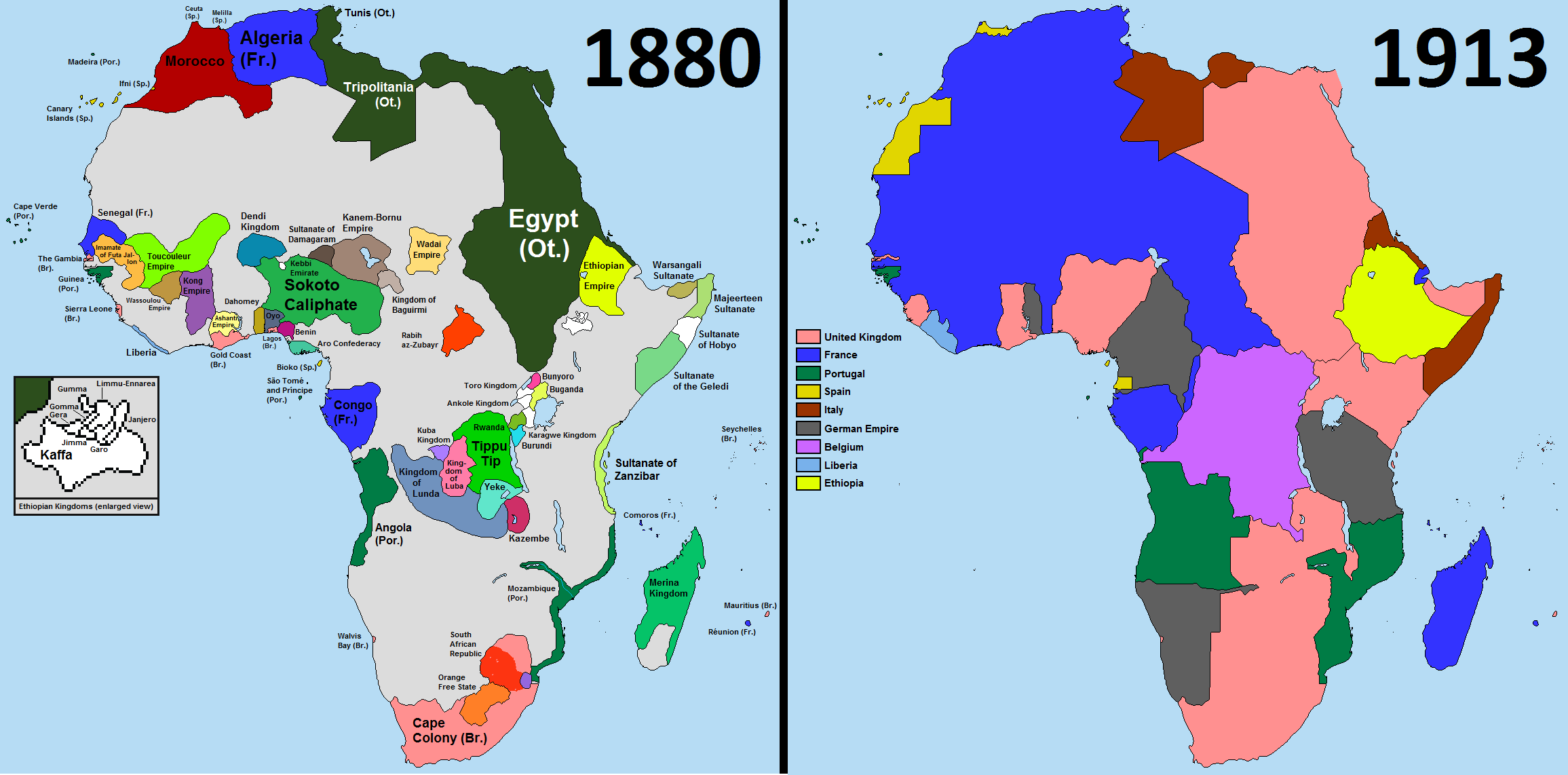
The colonial partitioning of the “Great African Cake”.
But just like a millennial trying to break into the Sydney property market, he found everything good was taken by the more established and well-to-do. The south was taken by the British and the Boers, Portugal had the old Kingdom of Kongo and Mozambique, the French, British and Spanish where all over west Africa like a bad smell, and East Africa was likewise taken by the Brits and Germans. But while the picturesque coastal properties were out of his reach, Leopold took heart to know that there still remained some 80% of the African landmass unthinkably (for the time) still under African rule and crying out for ‘protection’ as Leopold would later successfully frame it.
Leopold began following the exploits of African explorers most closely. Then, explorer extraordinaire Henry Morton Stanley came along, and opened up the heart of Africa like a fruit by tracking the Congo River from source to sea. And with that Leopold swooped on Congo with all the greed and grace of a seagull on a hot chip.
Target in sight, there still remained some significant problems for him, namely the Belgian people and parliament had no appetite for colonies. With ambition for power and plunder lacking he had to sell them a different story. He chose one of philanthropy, scientific discovery, moral responsibility, Christian duty and so-on and so-forth.
Working in Leopold’s favour was the warring in Sudan that saw Khartoum sacked, the Brits given the arse and General Charles George ‘China’ Gordon killed. Gordon was a devoted colonialist and had made a name for himself (quite literally) in China by bringing down the Taiping rebellion, which was rather bizarrely led by a Chinese Christian bloke convinced he was Jesus’ younger brother. A story for another time…
Anyhoo, Gordon goes to Sudan in the name of the Empire, feeling pretty shit hot after using far superior weaponry (and grasp on reality) to defeat his last enemy and is keen to do it again there. Only it doesn’t go well, and he finds himself a ‘Game of Thrones’ worthy death.

China Gordon meeting his end. His body was desecrated and thrown down a well, while his head was mounted in a tree by the evil child King Joffery…whoops I mean the Mahidists.
How this worked in Leopold’s favour was that Muslims thereafter were fiercely disliked, especially in England, the Mac Daddy of colonisers. And if killing the beloved China Gordon wasn’t enough, the leader of the Mahidists made himself as popular as a fart in a spacesuit by demanding Queen Victoria take a boat to Sudan, submit to his rule and convert to Islam.
http://31.media.tumblr.com/18bf6cafca4297d6d3d32f3f6bf9ea6b/tumblr_msv2kxrmTT1shgjp8o1_500.gif
This spurned an anti-Muslim fervor in England, which then caught on in Europe. Leopold was able to utilise this anti-Muslim sentiment for his own purposes… the first and last time in history a politician was ever able to do that… ahem. You see Leopold had found his ‘in’ into the Congo. He was going to oppose the ‘Afro Arab’ slave trade, then centered on the island of Zanzibar and sourcing its human wares from Central Africa. And with bait set, the international community took it hook, line and sinker.
Then with a breathtaking amount of political maneuvering and duplicity on the back of some serious House of Cards/Game of Thrones type scheming, Leopold got his colony. Leopold’s politicking at the time makes Frank Underwood and Little Finger appear positively small fry. Leopold managed to get the Congo Free State not under the name of Belgium, but under his own. An international consensus and stroke of a pen made him the world’s largest landowner, now in possession of a territory 76 times larger than Belgium itself. Leopold for the win!
And what does one do when granted unlimited power? Well, you abuse it… naturally. It started with the veracious plunder of ivory. But as much of the stuff as they took from the place, it wasn’t nearly enough to balance the Free State’s books. It wasn’t an instant success this colony. To help him “civilise” the Congo better he hired the “Afro-Arab” slavers to govern parts of the colony.

Ivory – the plastic of the day. Easy to carve and shape, used for piano keys, chess pieces, combs, canes, snuff boxes, you name it.
However success for Leopold and the real pain for Congo came when a veterinarian in Belfast helped fix his son’s tricycle wheel. Dunlop was his name and he had just invented the pneumatic tyre. The bicycle craze resulted and led headlong into the automobile craze, which ushered in a rubber rush of epic proportions.
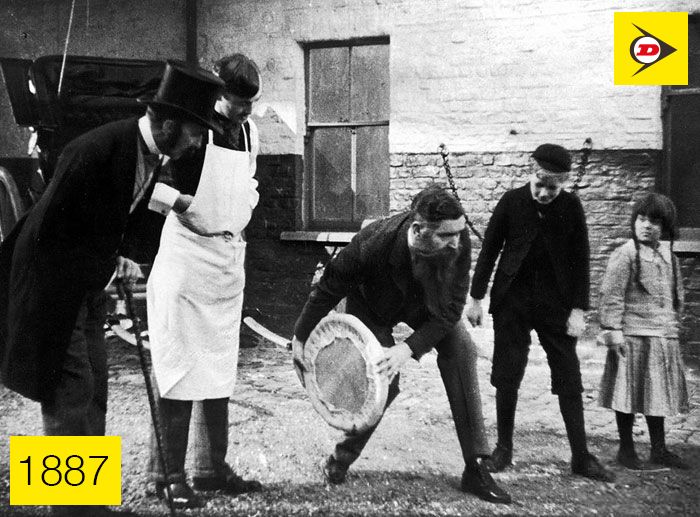
Dunlop testing out the innocent innovation of the pneumatic tyre that indirectly led to the deaths of millions. How’s that for a butterfly effect for ya?

Congolese tapping wild rubber vines
Cultivated rubber plantations would eventually spring up in colonies over the globe but these were time consuming and capital intensive to establish. This lag time granted Leopold, in possession of a huge country literally half covered in wild rubber vines, a significant head start in the rubber game. Twenty years, it turned out. In these twenty years Leopold employed the most brutal of tactics and unleashed new standards of cruelty to get as much rubber to Europe as humanly possible.
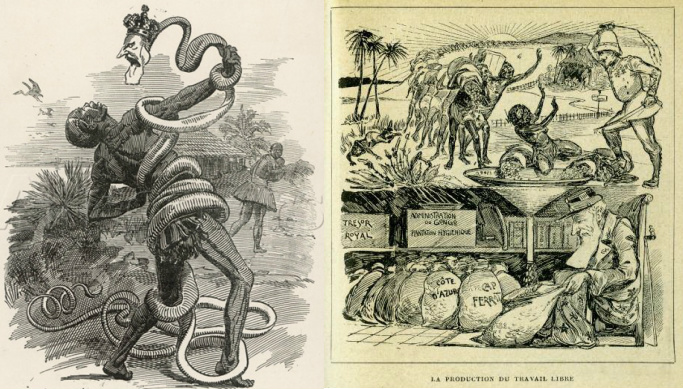
The world was not fooled by Leopold’s claims of noble intentions. Many saw it for what it was. Newspaper cartoons of 1908 and 1906.
Ever impossible quotas for rubber production were placed on villagers, which resulted in what was essentially enslavement. Villagers would have to spend 24 days a month in the jungle harvesting rubber in order to pay their taxes. This left precious little time or energy for farming. Starvation resulted. Not to mention death by overwork.
The ‘Force Publique’ was the name given to those charged with enforcing Leopold’s will across the colony. The tool of their sadistic trade was the chicotte, a whip made of dried hippopotamus hide with razor sharp ends. To compel the men to continue harvesting rubber, or in the words of the Force Publique, to keep their “volunteers” “motivated”, their wives and children were routinely kidnapped and held in cages, where, if they survived the abuse and starvation, they would be released when the quota was reached. Only to be taken again the following month. And that was the closest thing to a happy outcome for Congolese in the rubber areas.
When quotas weren’t met they faced amputation of hands or feet usually, but ears, noses and lips were also up for grabs. People more often than not did not survive the punishment. Often rather than incapacitate or kill the strong men through amputation the Forces Publique would cut the hands off his wife or children. It was quite simply a reign of terror, the brutality of which led Mark Twain (a fierce protestor against Leopold) to remark on “the white man’s notion that he is less savage than the other savages.”

“Nsala of Wala contemplates the severed hand and foot of his five-year-old daughter Boali, in 1904.” A military aide of Leopold’s told a story of how Leopold once saw a newspaper cartoon depicting him cutting off the hands of Congolese. Leopold scoffed saying “Cut off hands, that’s idiotic! I’d cut off all the rest of them, but not the hands. That’s the one thing I need in the Congo.” Years later his second illegitimate son (to his teenage former call girl mistress) was born with a deformed hand. Newspapers wildly critical of Leopold depicted the birth defect as ‘vengeance from on high’.

The movie Apocalypse Now was strongly inspired by the book ‘Heart of Darkness’, written by Joseph Conrad. Conrad had worked a year in the Congo Free State in 1890 and witnessed first hand the greed and human degeneration that later became the themes of his book. Despite one being set in Congo, the other in Vietnam, both explore the notion of a savagery at the heart of man and the violence and turmoil that can result from the imposition of one culture over another; through trade in the case of the book and war in the case of the movie.
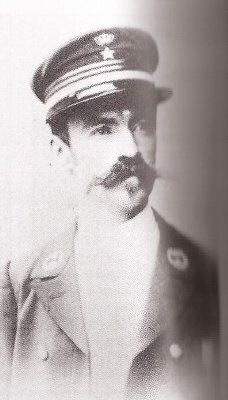
The Belgian Force Publique officer, Leon Rom. Both the movie and the book centre around a mysterious, almost God-like/anti-hero figure of Mr Kurtz (book) and Colonel Kurtz (Marlon Brando’s character in the movie). Leon Rom, is the person some historians think inspired the character. Rom’s barbarity was legendary and he was known to decorate his garden with human skulls, just like Mr Kurtz in the book and like Kurtz in the movie if memory serves. More than a century after his evil exploits Leon Rom became the bad guy in the 2016 movie remake of Tarzan. He has also served as the inspiration for the villian in two separate video games including one from 2012 game Spec Ops: The Line, which is a modernised adaptation of Heart of Darkness and has a similar Kurtz figure named Colonel John Konrad. Weird, hey.
But eventually the nightmare conditions in the Congo Free State reached the outside world. Much of the earlier reports came from missionaries and people with insufficient influence or media savvy to go against the cunning evil genius of Leopold. But eventually Leopold met his match in a principled British shipping clerk and gifted media man named Edmund Morel.
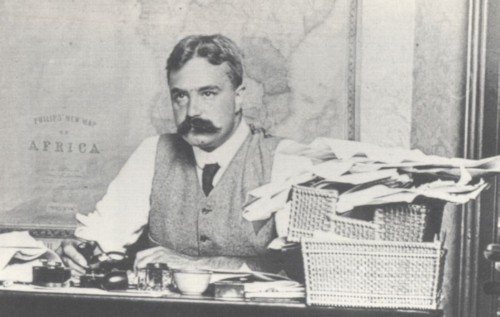
Edmund Morel became one of the greatest humanitarian crusaders of all time. Intelligent, fearless and incorruptible. Also had mad mo’ game.
Morel was working for a shipping company servicing the Free State and he noticed something was off when ship manifests showed untold riches constantly arriving in Belgium but little but arms, ammunition and chains were sent in return. Knowing that Congolese where not permitted to use cash, the only explanation for the trade imbalance was that the Congolese weren’t being paid for their work or commodities extracted; slave labour and wholesale theft in other words; perhaps the largest the world had ever seen. He didn’t take this lying down.

This fascinating Irish character, Rodger Casement, was also integral in exposing Leopold’s crimes in the Congo. Responding to public outcry the British government sent Casement to investigate Leopold’s Free State. Casement went deep into the matter and produced a report that laid bare Leopold’s reign of terror. He was later sent to do the same thing in the Amazon rubber plantation where, you won’t believe it, he uncovered worse atrocities. But his work with the subjugated people of the Congo and Amazon ignited his passion for Irish independence that led him to turn traitor against England when he made an arms and troop deal with the Germans in WW1. He was hung for treason in 1916, just 5 years after receiving a knighthood for his Congo/Amazon humanitarian work. An amazing tale (that becomes a bit sordid) you can read about in ‘The Dream of the Celt” by Mario Vagas Llosa.

One of the many grand constructions built by Leopold with his Congo profits. This is the Museum of Central Africa in Tervuren. Towards the end of his life he gifted all these constructions to the Belgian government – but not out of generosity. By gifting them to Belgium he still got to enjoy them but didn’t have to pay the huge sums to service and maintain them. It also helped him as he had for many years been trying to change Belgian inheritance law so his daughters (who he was not at all fond of) could not inherit any of his assets. He gave the assets away and the daughters missed out. This guy!
Have you ever looked back on horrific periods in history and wondered how ever did people stand by while this was happening? “Why didn’t they do anything?” History tends to record poorly the levels of opposition and resistance to some of its worst periods; the dissent and good intentions of many are often drowned out by the harshness of the episode in question. Well, take comfort in knowing that at the height of criticism for Leopold, the world was standing up to him. In the United States hundreds of protests against Leopold’s Congo were held. In England there were 300 hundred protests a year drawing as many as 5,000 people at a time. In Italy a duel was fought over it, even. Speeches in protests against him swept the world and even made it as far as Australia and New Zealand.
By 1908, the international pressure was so intense that Leopold had no recourse but to handover his Congo Free State to the Belgian government. But he was none too pleased about it so he made Belgium pay handsomely for it. Under Leopold’s orders, 8 full days were spent burning all records of the Congo Free State. Leopold is reported to have said, “I will give them my Congo, but they have no right to know what I did there.” And he did pretty well, for a pretty long time, at keeping much of his activities under wraps.
King Leopold II, commonly known as the ‘Butcher of the Congo’, died peacefully on the 44th anniversary of his coronation in December 1909, less than a year after handing over “his Congo”. In the 23 years of his rule over the Congo Free State, historians conservatively estimate Leopold personally amassed the equivalent of $1.1 billion in today’s money. In the same period it is believed the population of Congo was halved to around 10 million. All this, without ever setting foot in the place.
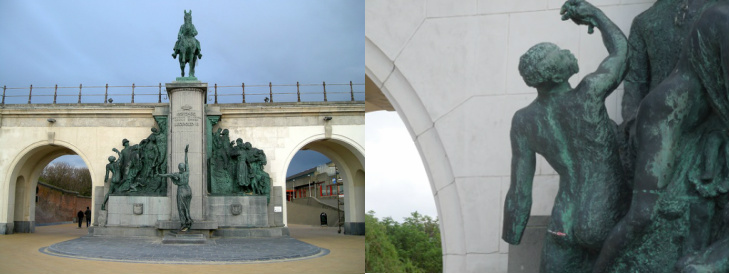
Belgium hasn’t done a great job of acknowledging the horrors of its past (like at all…at all)…but then again how many countries have? This monument called ‘Gratitude of the Congolese’ resides in the seaside town of Oostende, once beloved by King Leopold. It shows mostly Congolese men, at his feet looking up to Leopold with awe and respect, I guess. In 2004 a protest group removed one of the hands of the Congolese in recognition of the brutal practice that prevailed under Leopold. The council decided not to replace it. Hardly confronting ones history head-on but better than nothing I suppose.
When the Belgians took charge of the Free State they gave it a new name and made it technically illegal to randomly kill Congolese. Wow, much generous! Many humanity! What a time to be alive! However, whippings with the chicotte, terrorising Force Publique tactics and mutilations continued for many years. And just about every cent of profit extracted from the Congo went directly out of the country until independence in 1971.
Then their first democratically elected prime minister was executed.
Then civil war broke out.
And then came Mobutu.
The Horror! The Horror!
But fast-forward to November 2015 (yes, it really was that long ago), two infinitely less ambitious foreigners were getting tired after their day’s toil.
It was getting late into the afternoon and the storm clouds were gathering again. We started looking for a place to park up and camp for the night. But this side of Kananga, things weren’t going to be so easy camp-wise for us. The forest was just too dense to allow for pulling off the track and setting up camp. Any time we found somewhere to leave the track, it was drainage trenches that had been dug for collecting water. With the storm clouds threatening, none of these would do. It seemed bush camping was over and it was time to camp in villages.
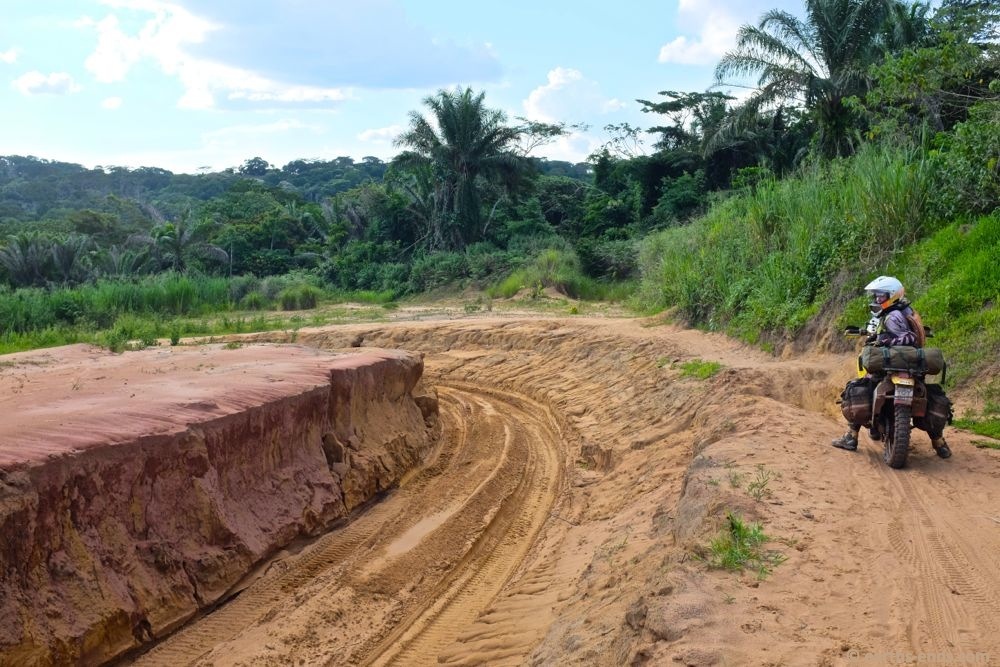
After looking for a place to leave the trail for some time we came across what you see in front of me. On inspection we found out they were irrigation ditches with no cover.

Ending the day on some easy…
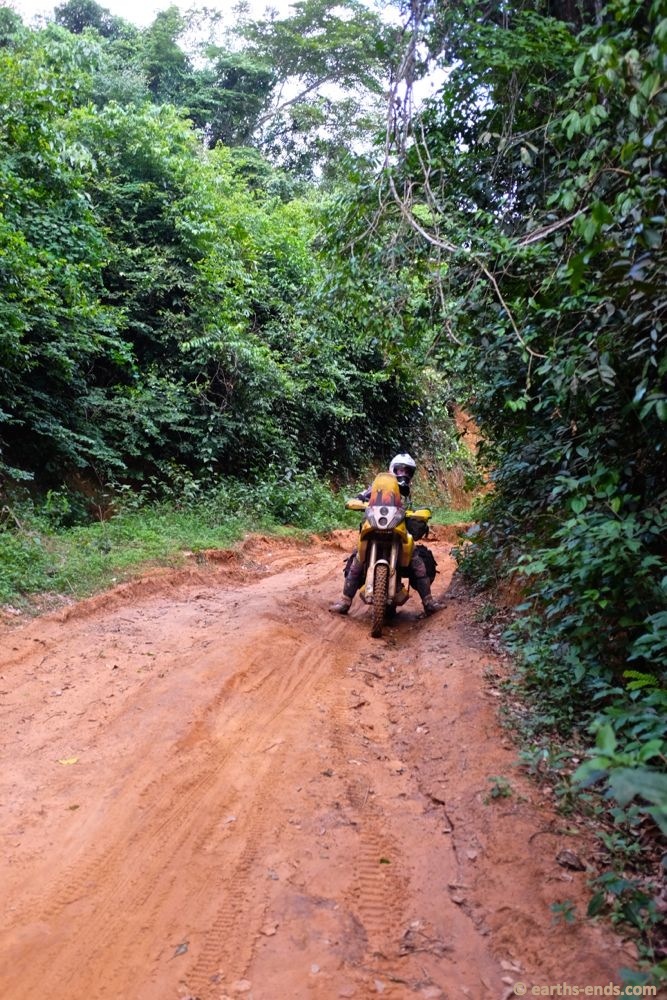
…yet slippery stuff.
We set about finding a village that gave us good vibes. We’ve read of some pretty scary experiences that had happened with other travellers when they chanced across some unsavory characters in not so hospitable villages. But we weren’t too concerned, as during our year and half on the road we had gained a quite reliable gut feeling and intuition when it came to people and places. For me the first sign of a good village is when you see kids and adults interacting with each other.
Sure enough we soon came upon a place with just that. It was also very small, very low key and shockingly poor. I had instant good feeling about the place so pulled up and asked in French for the chief of the locality. I don’t think much French was spoken in the village but they knew whom I was asking for. I was immediately taken to the old man in charge of the village. He was old and very frail and either mostly or fully blind. I could hear the villagers describing us to him.
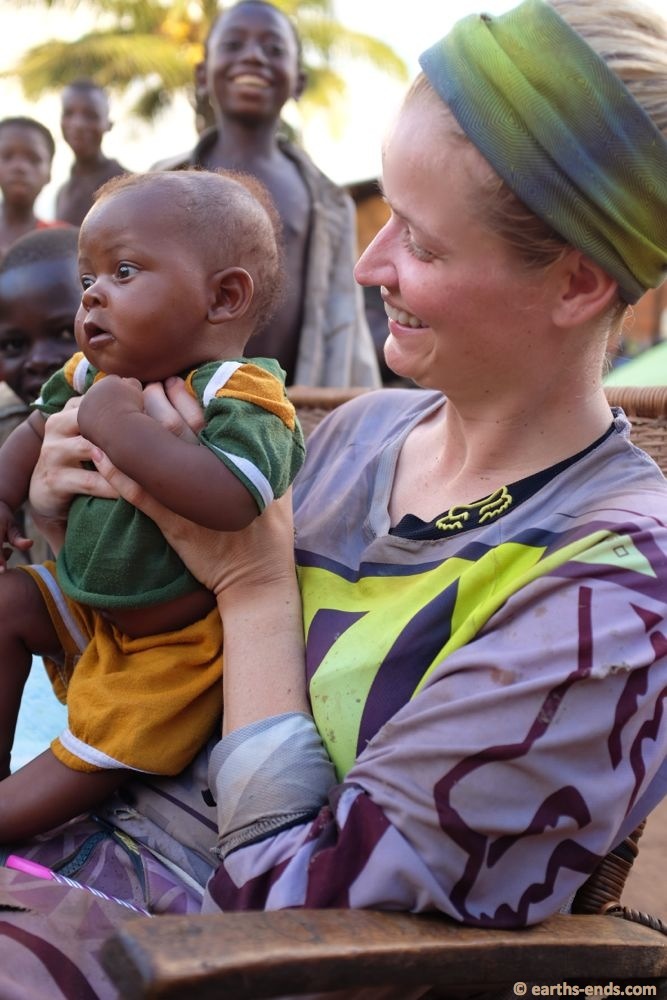
As soon as we showed up we were given chairs… and a baby.
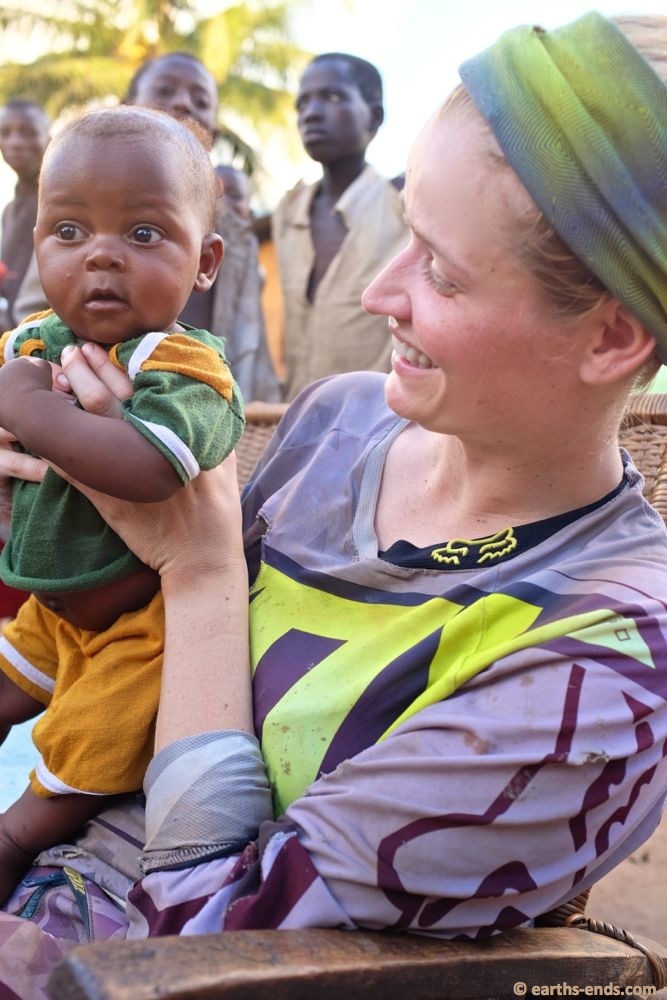
He was a cute little fella.

The kids were pretty excited by our presence.

Especially this guy.
The gentle old fella shook our hands and indicated we were welcome to stay the night and they told us we could put up our tent up right next to the chief’s house. We were under his hospitality now and we felt just about completely comfortable in the village and welcomed the thought of a good night’s sleep.

They were far from shy.
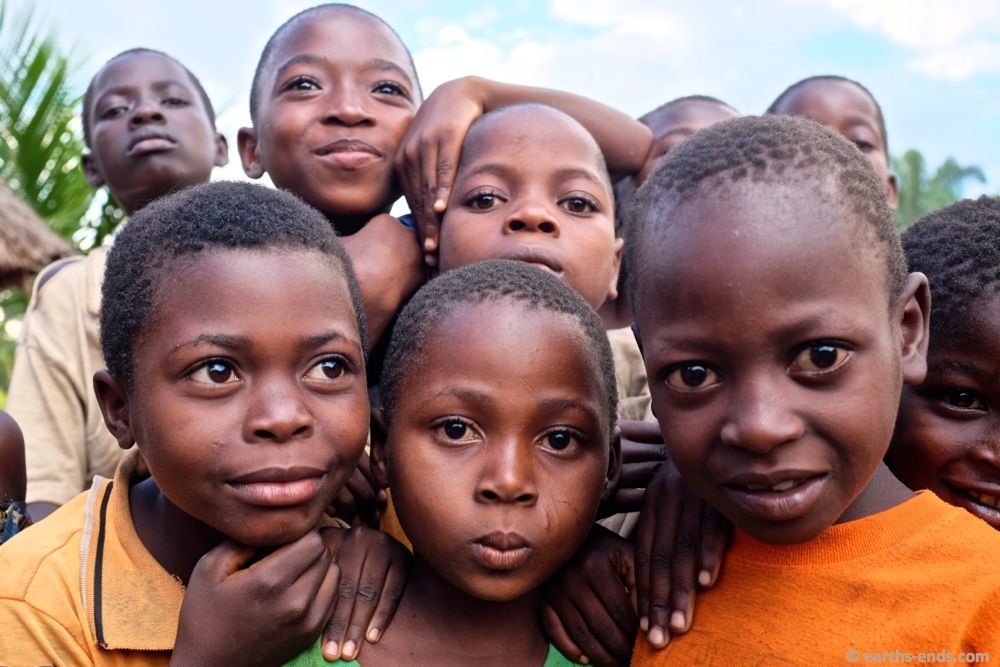
And very photogenic.

Our tent was between the chief’s hut and one of the wives huts.
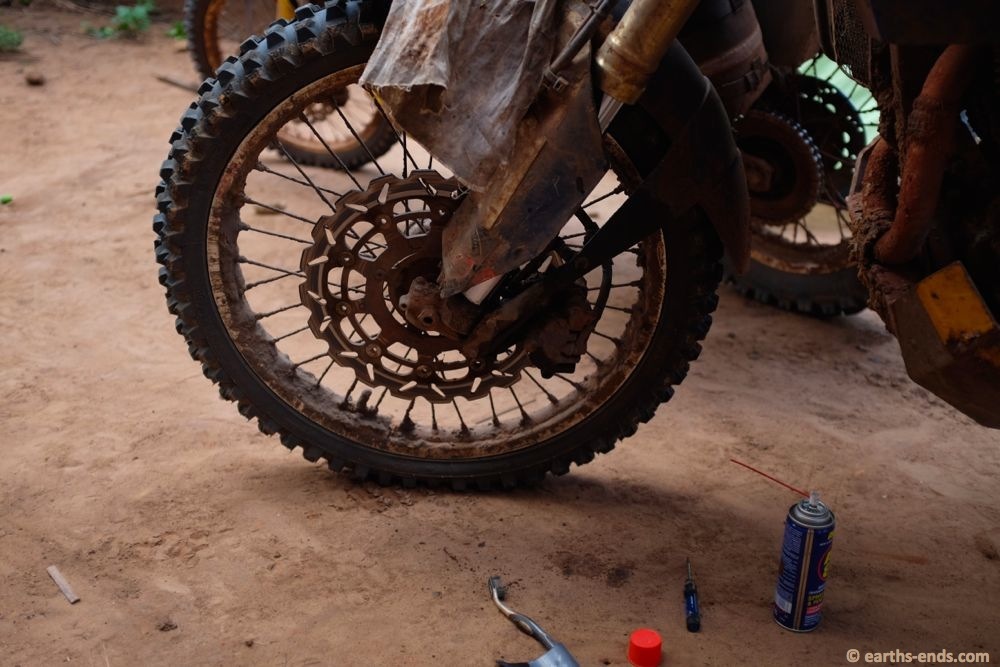
While we still had a tiny bit of energy left we scrubbed away mud from the lower stations with a toothbrush, and cleaned out the fork seals with some WD40.
After serving as the early evening entertainment for the kids of the village the storm clouds started to gather steam and people soon retired to their huts. As usual we hadn’t eaten all that much throughout the day and were looking forward to a quick salt-laden meal before retiring. We opted for the easiest option of a dehydrated space food meal between us and a cup of sweet tea. The rain started. How heavy it was and how long it fell for remained unknown to us. Sleep came within moments of putting head to pillow.
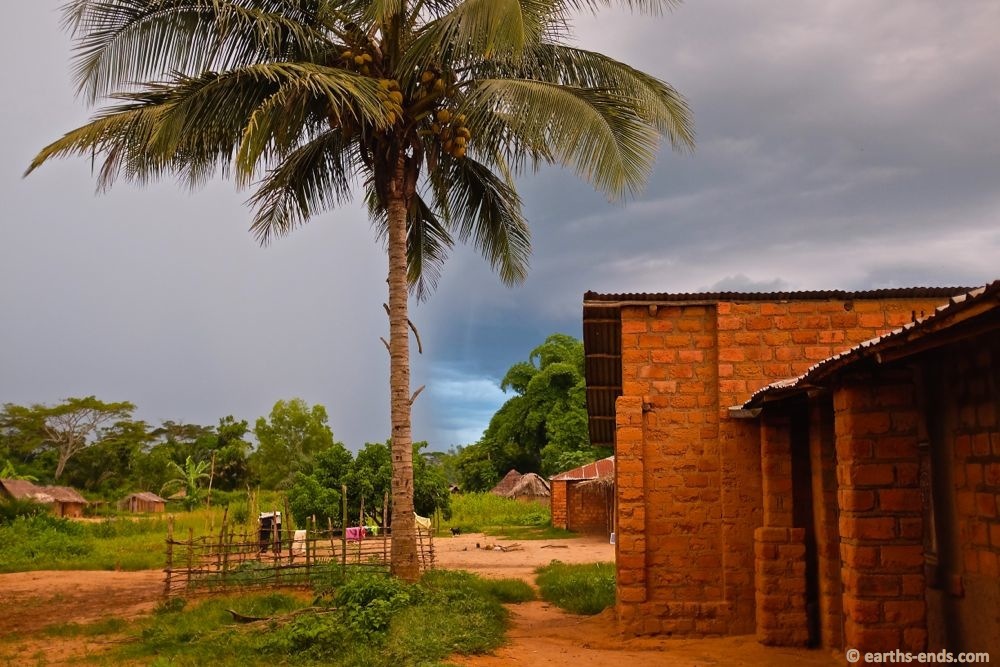
This brick hut with corrugated iron belonged to the old chief. We were too shy to ask for his photo.
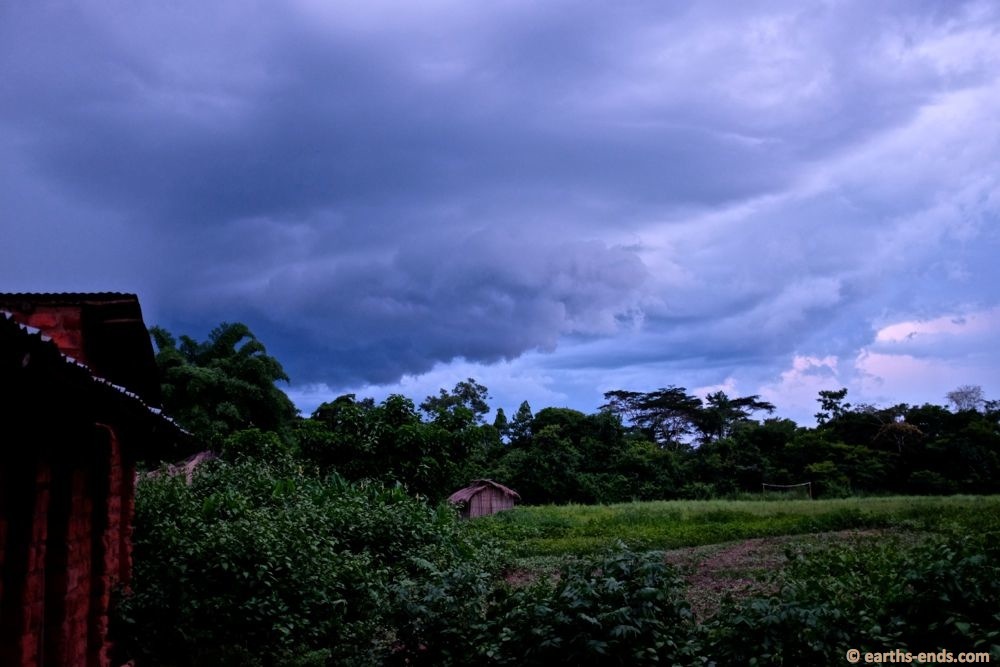
Congo storm clouds-a-brewin’
 Earths-Ends
Earths-Ends
More great stuff,love the history parts. It seems Mobutu was financed to power by the US.
Funny how that works.